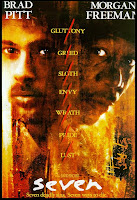Opening Titles
They are presented in a white, easy-to-read font on a contrasting black background. The text flashes onto the screen quickly, before fading away again. After a short time, a larger font in red capital letters flashes up- announcing the film's title. Red is significant because it is a connotation of danger, as well as fitting the theme of "red eye".
Generic ThemesAs soon as the action begins, some sort of conspiricy is established. The camera stalks the characters without showing faces, revealing some sense of character and family history via the photographs on the table, the contents of the wallet etc. It is slightly unclear to the audience at this point who is involved and why but all the same it puts you on edge.
The sequence that follows this mysterious opening begins answering some of the questions in the audience's mind- who is the owner of the wallet? who is the lady? why is she important? But still there is an ethos of ambguity to keep the audience guessing.
Because no faces are seen at first, this suggests that there is someone/some authority carrying out orders that wish to remain unseen. This sets up lots of plot twists for later in the film. The idea of someone/something being in control of the situation from a distance is often used in psychological thrillers in order to keep information withheld from viewers.
A strong, confident, intelligent female is introduced as the protagonist character, which immediately sets the film apart from others I have seen.
SoundDiegetic~ noises that fit the action (banging of crates, slam of the truck door, turning pages of the hotel documents etc) are all exaggerated to heighten the tension in the opening scene. Eventually dialogue is introduced.
Non-Diegetic~ sinister music is played over the opening titles. After a climatic point that happens at the same time as the film title is seen, it goes temporarily quiet, a slight echo is heard. Inanimate objects are seen and as a character comes into shot, the music restarts atmospherically.
Mise-en-scene~The wallet is shown close up and highlighted as a key prop. This is reinforced as the motif of the wallet is repeated- we see it go on a journey with other characters
~The film takes place at nighttime, straight away adding danger and intrigue to the plot
~A sympathetic background is used to reflect the themes and add danger/anxiety to the events taking place. For example, the rain and traffic are delaying her in the taxi (building suspense), the storm effecting the flights at the airport (immediately placing objects in the way of the situation)
~We find out lots about the central character from small details, eg. she is in a graduation gown in the photograph (suggesting she is an intelligent woman), she is the person who people ring in a crisis (a reliable, trust worthy character), she does not get stressed or flustered in traffic, when the flight is delayed, during the phonecall etc, implying she is in control)
~Photographs on the table begin to build up a family history, encouraging the audience to empathise with these characters
~The combination of smart suits, suspicious behaviour and nighttime setting suggest corruption or a bad authority/organisation
~The hotel lobby is bright, light and colourful, even the costumes are cheerful. This contrasts greatly to the dreery, dark atmosphere created in and around the taxi. This could be setting up the idea that the protagonist is doomed or heading for danger
Shot Types*Plenty of CUs used in the opening sequence. The director is focussing our attention to certain details and disorientating us because we cannot see the full picture
*POV shots are used, particularly when the wallet it placed on the side and then stolen. This shows the action taking place but doesn't give the audience all the information, adding suspense. It also puts the 'bad' characters in a position of power
*A slight worm's eye view of the truck hides the identity of the characters involved and gives the audience a low status, making them feel vulnerable
*Both a medium shot and a two shot are used in the hotel scene. These are slightly less intense than all of the close ups used previously but they still serve the same purpose- only showing the audience what is relevant rather than giving lots of other details away
Camera MovementThere are moments of stillness inbetween some rapid movements, creating an eery, tense atmosphere. A slow, short pan is used to reveal slightly more of the environment before characters enter. Some fast tracking is used to follow the action. It is done smoothly as opposed to using steady cam, possibly to give the idea that we are absent viewers witnessing the situation, rather than another character taking part in the action. Some of the camera movements are quite fast, meaning you only get a glimpse of certain things. It begins to build a fast paced, organised feeling to the crime that is being planned.





